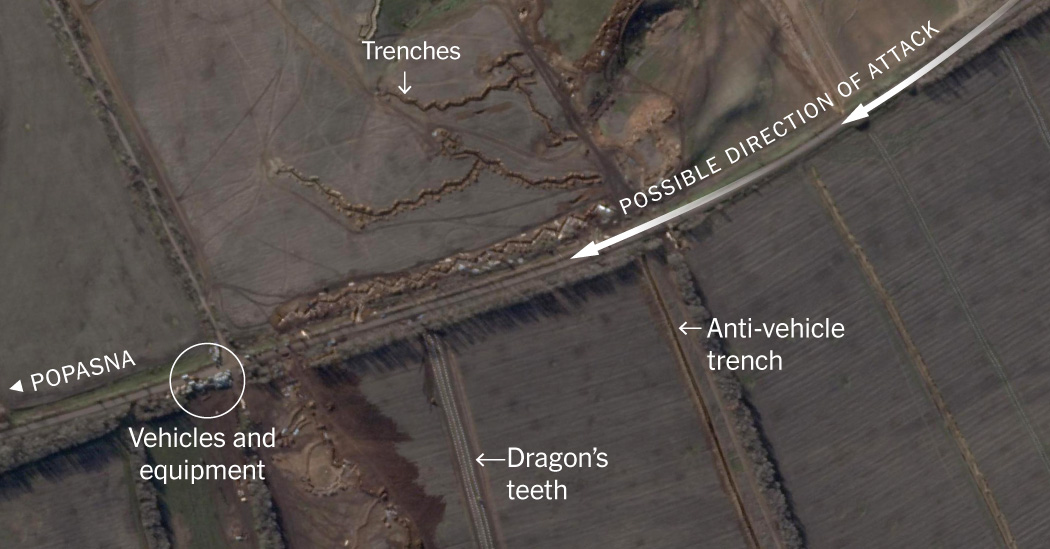Trenches are not new to Ukraine. Trench warfare has long been a feature of the battle in eastern Ukraine for the Donbas region. Ukrainians fight from their own trenches on their side of the line near Popasna, where Russians are waging an intense campaign to dislodge Ukrainian troops from the city of Bakhmut.
But the pace and the scale of Russian construction over the last couple of months is unmatched. All of the structures in the image above appeared within six days.
The fortifications show how Russia’s military is trying to set up more robust, defensible positions against Ukrainian pressure, often with the help of natural obstacles like rivers.
Last month, Ukraine recaptured a large amount of territory in the south, including the regional capital of Kherson, pushing Russian forces across the Dnipro River. The river serves as a natural barrier, and Russia has built an enormous series of defensive obstacles south of the river to discourage Ukraine from crossing it.
A map of Ukraine showing territory occupied by Russia, and where fortifications have been detected.
Fortifications built
on eastern front
Fortifications built
on southern front

Fortifications built
on eastern front
Fortifications built
on southern front
Source: Areas of control by Institute for the Study of War with American Enterprise Institute’s Critical Threats as of Dec. 8
The New York Times
Among the defenses are miles-long rows of concrete pyramids known as dragon’s teeth and deep ditches called tank traps. Both are designed to slow Ukrainian vehicles and force them into preset positions where Russian forces can target them.
Video frames of rows of concrete dragon’s teeth and a tank trap dug deep into the earth.

A tank trap about
13 miles long

A tank trap about
13 miles long
Source: Images from RiaMelitopolTV on Telegram via zaporizhjia.info posted on Nov. 26
The New York Times
Russia is also building miles of trenches, and pillboxes — small structures for their troops to shoot from.
An illustration of the main defensive structures built by Russians in Ukraine: an anti-vehicle trench, dragon’s teeth and pillboxes.

Pits could stop tanks if they are deep enough.
These pyramid-shaped concrete structures serve as obstacles for vehicles. If not dug deep enough, they could be removed with bulldozers or demolished with explosives.
Trenches can be dug at a rate of up to a half mile per hour with Soviet BTM-3 trenchers, even when the ground is frozen.

Pits could stop tanks if they are deep enough.
These pyramid-shaped concrete structures serve as obstacles for vehicles. If not dug deep enough, they could be removed with bulldozers or demolished with explosives.
Trenches can be dug at a rate of up to a half mile per hour with Soviet BTM-3 trenchers, even when the ground is frozen.

Pits could stop tanks if they are deep enough.
These pyramid-shaped concrete structures serve as obstacles for vehicles. If not dug deep enough, they could be removed with bulldozers or demolished with explosives.
Trenches can be dug at a rate of up to a half mile per hour with Soviet BTM-3 trenchers, even when the ground is frozen.

Pits could stop tanks if they are deep enough.
These pyramid-shaped concrete structures serve as obstacles for vehicles. If not dug deep enough, they could be removed with bulldozers or demolished with explosives.
Trenches can be dug at a rate of up to a half mile per hour with Soviet BTM-3 trenchers, even when the ground is frozen.
Source: Satellite imagery, photographs, military analysts
The New York Times
The fortifications could slow Ukraine’s army — but they are effective only if manned correctly.
If the positions are unmanned, they are useful only if there is an orderly Russian retreat, one of the most difficult tactical operations to conduct, said Philip Wasielewski, a fellow at the Foreign Policy Research Institute.
“There’s no guarantee that those soldiers will make it to those fortifications. Or once they get there, not just keep running,” Mr. Wasielewski said. “These are just holes in the ground unless they are held by motivated, disciplined soldiers, who are supported by artillery, mobile reserves and logistics.”
To better understand Russia’s fortifications in eastern Ukraine, The Times analyzed satellite radar data on physical changes to the earth’s surface. That data, along with high-resolution satellite imagery from Planet Labs, reveals multiple rows of Russian defenses lining major highways just behind the Russian frontlines.
A map of defensive fortifications near the city of Popasna, in eastern Ukraine.
Russian defensive fortifications built in November

Russia has built
multiple defensive
lines behind the
frontline on the
outskirts of Popasna.
Area shown in the
satellite image
at top of page

Russia has built multiple
defensive lines behind the
frontline on the outskirts
of Popasna.
Area shown in
the satellite
image at top
of page

Russia has built multiple
defensive lines behind the
frontline on the outskirts
of Popasna.
Area shown in the
satellite image at
top of page
Sources: Times analysis of satellite data from Planet Labs from Nov. 29. Areas of control by Institute for the Study of War with American Enterprise Institute’s Critical Threats as of Dec. 8. Basemap data by OpenStreetMaps
The New York Times
Russia remains on the offensive near Bakhmut, slamming the city with artillery and slowly gaining ground to the east and south of the city over the past two weeks. The new construction provides several defensible positions to retreat to, should the Ukrainians counterattack.
That could help Russia avoid a repeat of its costly withdrawal from the Kharkiv region in September, when it lost thousands of square miles of territory and was forced to abandon military equipment.
One network of Russian defenses near Popasna was constructed in just 11 days. Satellite data from Popasna shows new rows of defensive structures snaking north across open fields.
A radar data map showing a sequence of new fortifications being built in the outskirts of the city of Popasna in November.

Rows of
defensive
structures

Rows of
defensive
structures
Source: Sentinel-1 satellite data from Copernicus
The New York Times
Some Russian military bloggers have been openly critical of Russia’s construction of a fortified frontline. In a Telegram post on Dec. 6, Igor Strelkov, a Russian former intelligence officer, said the decision to build long-term structures had been made “on a whim.”
“Following the strategy of a protracted war is suicide for the Russian Federation,” he said.
While trench warfare is associated with the major wars of the 20th century, trenches and obstacles can still play an important role in modern warfare by shaping where an enemy can attack, said Ben Barry, a senior fellow at the International Institute for Strategic Studies.
“The whole idea of defensive positions is to get an advantage by being able to fight from prepared positions,” Mr. Barry said.
The Soviets used these types of defenses to successfully defend against a German attack on the city of Kursk during World War II. Moscow views this as the model of a Russian defensive battle, Mr. Barry said.
“They knew the Germans were attacking there. So they built defenses in great depth and had many belts of obstacles and minefields and belts of defense and also powerful reserves,” he said.
But trenches have modern weaknesses as well. Many of them are being built out in the open, within striking distance of Ukrainian artillery, making them especially vulnerable to being spotted by drones.
Constructing these defenses so near to Ukrainian forces has very likely led to heavy Russian casualties near the town of Svatove in eastern Ukraine, Britain’s Ministry of Defense said in a statement.
An analysis published in late November by the Institute for the Study of War, an American research group, showed that Russia also built defensive positions deep in southern Kherson in October before it ordered a withdrawal from territory north of the Dnipro River.
A map showing defensive structures built by the Russians in Kherson Oblast.
Defensive fortifications built since late October


Sources: Institute for the Study of War with American Enterprise Institute’s Critical Threats Project
Note: Area of control as of Dec. 8
The New York Times
Russia’s fortifications are much further from the frontlines in Kherson than in eastern Ukraine. New structures have been spotted more than 50 miles from the Dnipro River, which now serves as a natural barrier between the two sides.
Military experts said that Russia is likely moving to the defense in Kherson so it can redeploy forces to more active fronts in the war, such as Bakhmut.
Even so, it is a signal that “the Russian military leadership views the prospect of a Ukrainian counteroffensive across the Dnipro River as a serious threat,” according to an assessment by the Institute for the Study of War.
Ukraine has already made an amphibious landing on a strategically vital peninsula at the mouth of the Dnipro River. Known as the Kinburn Spit, the peninsula could serve as a base for Ukrainian attacks deep into Kherson, so Russia has heavily fortified a two-mile-wide strip of land separating the spit from the mainland.
New fortifications in Kherson
Source: Satellite images by Maxar Technologies, Nov. 15, 2022
The New York Times
Many of the fortifications are designed to protect supply lines that connect southern Kherson to Crimea, the peninsula that Russia illegally annexed in 2014. Losing even one of the two main highways “would likely strain Russian logistics supporting operations” in eastern Kherson and western Zaporizhia, according to the Institute for the Study of War.
Defensive positions can be seen every five miles on the major M14 highway that runs from Kherson to Melitopol, a city in the Zaporizhia region that Russia captured in the early days of the war.
A satellite image showing a section of the M14 motorway with multiple fortifications built by the Russians.
Source: Satellite image by Planet Labs, Nov. 23, 2022
The New York Times
Ultimately the success of these defensive structures depends on the quality of the troops defending them. Russia mobilized hundreds of thousands of fresh recruits in September, but many of them arrived on the battlefield poorly trained and unequipped.
Russia has likely deployed these new recruits to frontline defenses in Kherson, saving more experienced troops for secondary positions, analysts at the Institute for the Study of War wrote late last month.
“Manning Russian frontline fortifications with these less effective, less organized, and poorly equipped and supplied personnel could lead to them collapsing or falling back faster than Russian military leadership may have planned,” the analysts wrote.



